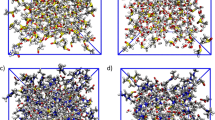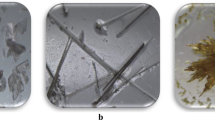Abstract
We present the results of experimental and computational studies of the physicochemical properties and structure of a newly synthesized tripropylammonium 2-sulfobenzoate (TPrA/SBA) protic ionic liquid (PIL). Quantum-chemical methods were used to evaluate the hydrogen-donor properties of the SBA molecule and to model the proton transfer between the acid and base molecules. The results revealed that the ionic liquid was formed through an acid-base interaction between the proton of the –SO3H group in the acid and the nitrogen atom in the amine. Additionally, we conducted a molecular dynamics simulation to determine the hydrogen bond topology in the PIL bulk as well as the average number of hydrogen bonds between the ions. To provide further insights, we compared the structural parameters and properties of the TPrA/SBA ionic liquid with the data on the two other tripropylammonium-based PILs with hydrogen sulfate (SA) and triflate (TfO) anions.









Similar content being viewed by others
Availability of data and materials
The data that support the findings of this study are available from the corresponding author upon reasonable request.
Code availability
Not applicable.
References
Khoo KS, Chia WY, Wang K, Chang C-K, Leong HY, Bin Maaris MN, Show PL (2021) Development of proton-exchange membrane fuel cell with ionic liquid technology. Sci Total Environ 793:148705. https://doi.org/10.1016/j.scitotenv.2021.148705
Escorihuela J, Olvera-Mancilla J, Alexandrova L, Felipe del Castillo L, Compañ V (2020) Recent progress in the development of composite membranes based on polybenzimidazole for high temperature proton exchange membrane (PEM) fuel cell applications. Polymers 12:1861. https://doi.org/10.3390/polym1209186
Wong CY, Wong WY, Loh KS, Lim KL (2022) Protic ionic liquids as next-generation proton exchange membrane materials: current status & future. React Funct Polym 171:105160. https://doi.org/10.1016/j.reactfunctpolym.2022.105160
Seng LK, Masdar MS, Shyuan LK (2021) Ionic liquid in phosphoric acid-doped polybenzimidazole (PA-PBI) as electrolyte membranes for PEM fuel cells: a review. Membranes 11:728. https://doi.org/10.3390/membranes11100728
Elwan HA, Mamlouk M, Scott K (2021) A review of proton exchange membranes based on protic ionic liquid/polymer blends for polymer electrolyte membrane fuel cells. J Power Sources 484:229197. https://doi.org/10.1016/j.jpowsour.2020.229197
Bakonyi P, Koók L, Rózsenberszki T, Tóth G, Bélafi-Bakó K, Nemestóthy N (2020) Development and application of supported ionic liquid membranes in microbial fuel cell technology: a concise overview. Membranes 10:16. https://doi.org/10.3390/membranes10010016
Yoshizawa M, Xu W, Angell CA (2003) Ionic liquids by proton transfer: vapor pressure, conductivity, and the relevance of ΔpKa from aqueous solutions. J Am Chem Soc 125:15411–15419. https://doi.org/10.1021/ja035783d
Belieres J-P, Angell CA (2007) Protic ionic liquids: Preparation, characterization, and proton free energy level representation. J Phys Chem B 111:4926–4937. https://doi.org/10.1021/jp067589u
Miran MS, Kinoshita H, Yasuda T, Susan MABH, Watanabe M (2012) Physicochemical properties determined by ΔpKa for protic ionic liquids based on an organic super-strong base with various Brønsted acids. Phys Chem Chem Phys 14:5178–5186. https://doi.org/10.1039/C2CP00007E
Hayes R, Warr GG, Atkin R (2015) Structure and nanostructure in ionic liquids. Chem Rev 115:6357–6426. https://doi.org/10.1021/cr500411q
Hayes R, Imberti S, Warr GG, Atkin R (2013) The nature of hydrogen bonding in protic ionic liquids. Angew Chem Int Ed 52:4623–4627. https://doi.org/10.1002/anie.201209273
Wei Y, Xu T, Zhang X, Di Y, Zhang Q (2018) Thermodynamic properties and intermolecular interactions of a series of n-butylammonium carboxylate ionic liquids. J Chem Eng Data 63:4475–4483. https://doi.org/10.1021/acs.jced.8b00583
Mann SK, Brown SP, MacFarlane DR (2020) Structure effects on the ionicity of protic ionic liquids. Chem Phys Chem 21:1444–1454. https://doi.org/10.1002/cphc.202000242
Stoimenovski J, Izgorodina EI, MacFarlane DR (2010) Ionicity and proton transfer in protic ionic liquids. Phys Chem Chem Phys 12:10341–10347. https://doi.org/10.1039/c0cp00239a
Lv Y, Guo Y, Luo X, Li H (2012) Infrared spectroscopic study on chemical and phase equilibrium in triethylammonium acetate. Sci China Chem 55:1688–1694. https://doi.org/10.1007/s11426-012-4634-6
Bodo E (2020) Structural features of triethylammonium acetate through molecular dynamics. Molecules 25:1432. https://doi.org/10.3390/molecules25061432
Berton P, Kelley SP, Wang H, Rogers RD (2018) Elucidating the triethylammonium acetate system: Is it molecular or is it ionic? J Mol Liq 269:126–131. https://doi.org/10.1016/j.molliq.2018.08.006
Shmukler LE, Fedorova IV, Gruzdev MS, Safonova LP (2019) Triethylamine-based salts: protic ionic liquids or molecular complexes? J Phys Chem B 123:10794–10806. https://doi.org/10.1021/acs.jpcb.9b08032
Reid JESJ, Bernardes CES, Agapito F, Martins F, Shimizu S, Minas da Piedade ME, Walker AJ (2017) Structure-property relationships in protic ionic liquids: a study of solvent-solvent and solvent-solute interactions. Phys Chem Chem Phys 19:28133–28138. https://doi.org/10.1039/c7cp05076c
Davidowski SK, Thompson F, Huang W, Hasani M, Amin SA, Angell CA, Yarger JL (2016) NMR characterization of ionicity and transport properties for a series of diethylmethylamine based protic ionic liquids. J Phys Chem B 120:4279–4285. https://doi.org/10.1021/acs.jpcb.6b01203
Mariani A, Bonomo M, Gao X, Centrella B, Nucara A, Buscaino R, Barge A, Barbero N, Gontrani L, Passerini S (2021) The unseen evidence of reduced ionicity: the elephant in (the) room temperature ionic liquids. J Mol Liq 324:115069. https://doi.org/10.1016/j.molliq.2020.115069
Miran MS, Yasuda T, Susan MABH, Dokko K, Watanabe M (2012) Protic ionic liquids based on a super-strong acid: bulk and electrochemical properties. ECS Trans 50:285–291. https://doi.org/10.1149/05011.0285ecst
Fedorova IV, Shmukler LE, Fadeeva YA, Gruzdev MS, Safonova LP (2023) On structure and properties of tripropylammonium-based protic ionic liquids with bis(trifluoromethylsulfonyl)imide and hydrogen sulfate anions. Ionics 29:661–674. https://doi.org/10.1007/s11581-022-04844-5
Shmukler LE, Fedorova IV, Fadeeva YA, Safonova LP (2021) The physicochemical properties and structure of alkylammonium protic ionic liquids of RnH4-nNX (n=1–3) family. A mini-review J Mol Liq 321:114350. https://doi.org/10.1016/j.molliq.2020.114350
Greaves TL, Drummond CJ (2008) Protic ionic liquids: properties and applications. Chem Rev 108:206–237. https://doi.org/10.1021/cr068040u
Greaves TL, Drummond CJ (2015) Protic ionic liquids: evolving structure−property relationships and expanding applications. Chem Rev 115:11379–11448. https://doi.org/10.1021/acs.chemrev.5b00158
Fiedler P, Bohm S, Kulhanek J, Exner O (2006) Acidity of ortho-substituted benzoic acids: an infrared and theoretical study of the intramolecular hydrogen bonds. Org Biomol Chem 4:2003–2011. https://doi.org/10.1039/B601875K
Böhm S, Fiedler P, Exner O (2004) Analysis of the ortho effect: acidity of 2-substituted benzoic acids. New J Chem 28:67–74. https://doi.org/10.1039/B305986C
Wiberg KB (2002) Substituent effects on the acidity of weak acids. 2. Calculated gas-phase acidities of substituted benzoic acids. J Org Chem 67:4787–4794. https://doi.org/10.1021/jo020100i
Advanced Chemistry Development (ACD/Labs) Software V11.02 (© 1994–2017 ACD/Labs) (predict)
Becke AD (1993) Density-functional thermochemistry. III. The role of exact exchange. J Chem Phys 98:5648–5652. https://doi.org/10.1063/1.464913
Lee C, Yang W, Parr RG (1988) Development of the Colle-Salvetti correlation-energy formula into a functional of the electron density. Phys Rev B 37:785. https://doi.org/10.1103/PhysRevB.37.785
Grimme S, Antony J, Ehrlich S, Krieg H (2010) A consistent and accurate ab initio parametrization of density functional dispersion correction (DFT-D) for the 94 elements H-Pu. J Chem Phys 132:154104. https://doi.org/10.1063/1.3382344
Ditchfield R, Hehre WJ, Pople JA (1971) Self-consistent molecular-orbital methods. IX. An extended gaussian-type basis for molecular-orbital studies of organic molecules. J Chem Phys 54:724–728. https://doi.org/10.1063/1.1674902
Frisch MJ, Trucks GW, Schlegel HB, Scuseria GE, Robb MA, Cheeseman JR, Scalmani G, Barone V, Mennucci B, Petersson GA, Nakatsuji H, Caricato M, Li X, Hratchian HP, Izmaylov AF, Bloino J, Zheng G, Sonnenberg JL, Hada M, Ehara M, Toyota K, Fukuda R, Hasegawa J, Ishida M, Nakajima T, Honda Y, Kitao O, Nakai H, Vreven T, Montgomery JA, Peralta JE, Ogliaro F, Bearpark M, Heyd JJ, Brothers E, Kudin KN, Staroverov VN, Kobayashi R, Normand J, Raghavachari K, Rendell A, Burant JC, Iyengar SS, Tomasi J, Cossi M, Rega N, Millam JM, Klene M, Knox JE, Cross JB, Bakken V, Adamo C, Jaramillo J, Gomperts R, Stratmann RE, Yazyev O, Austin AJ, Cammi R, Pomelli C, Ochterski JW, Martin RL, Morokuma K, Zakrzewski VG, Voth GA, Salvador P, Dannenberg JJ, Dapprich S, Daniels AD, Farkas O, Foresman JB, Ortiz JV, Cioslowski J, Fox DJ (2009) Gaussian 09, revision A.01. Gaussian, Inc., Wallingford
Barone V, Cossi M (1998) Quantum calculation of molecular energies and energy gradients in solution by a conductor solvent model. J Phys Chem A 102:1995–2001. https://doi.org/10.1021/jp9716997
Cossi M, Rega N, Scalmani G, Barone V (2003) Energies, structures, and electronic properties of molecules in solution with the C-PCM solvation model. J Comput Chem 24:669–681. https://doi.org/10.1002/jcc.10189
Besler BH, Merz KM, Kollman PA (1990) Atomic charges derived from semiempirical methods. J Comp Chem 11:431–439. https://doi.org/10.1002/jcc.540110404
Piela L (2007) Ideas of Quantum Chemistry. Elsevier Science Publishers, Amsterdam, the Netherlands
Boys S, Bernardi F (2002) The calculation of small molecular interactions by the differences of separate total energies. Some procedures with reduced errors. Mol Phys 19:553–566. https://doi.org/10.1080/00268977000101561
Espinosa E, Molins E, Lecomte C (1998) Hydrogen bond strengths revealed by topological analyses of experimentally observed electron densities. J Chem Phys Lett 285:170–173. https://doi.org/10.1016/S0009-2614(98)00036-0
Bader RFW (1985) Atoms in molecules. Acc Chem Res 18:9–15. https://doi.org/10.1021/ar00109a003
Bader RFW (1990) Atoms in Molecules - A Quantum Theory. Oxford University Press, Oxford
Bader PFW (1991) A quantum theory of molecular structure and its applications. Chem Rev 91:893–928. https://doi.org/10.1021/cr00005a013
Keith TA (2010) AIMAll, version 10.05.04 (aim.tkgristmill.com)
Smith W, Yong CW, Rodger PM (2002) DL_POLY: Application to molecular simulation. Mol Simul 28:385–471. https://doi.org/10.1080/08927020290018769
Wang J, Wolf RM, Caldwell JW, Kollman PA, Case DA (2004) Development and testing of a general amber force field. J Comp Chem 25:1157–1174. https://doi.org/10.1002/jcc.20035
Youngs TG (2009) Aten – an application for the creation, editing, and visualization of coordinates for glasses, liquids, crystals, and molecules. J Comput Chem 31:639–648. https://doi.org/10.1002/jcc.21359
Kazuki M, Syu H, Tomoaki Y, Kazuhisa S (2010) Structural and spectroscopic characteristics of a proton-conductive ionic liquid diethylmethylammonium trifluoromethanesulfonate [dema][TfOH]. Bull Chem Soc Jpn 83:328–334. https://doi.org/10.1246/bcsj.20090209
Pinto RR, Mattedi S, Aznar M (2015) Synthesis and physical properties of three protic ionic liquids with the ethylammonium cation. Chem Eng Trans 43:1165–1170. https://doi.org/10.3303/CET1543195
Paschoal VH, Faria LFO, Ribeiro MCC (2017) Vibrational spectroscopy of ionic liquids. Chem Rev 117:7053–7112. https://doi.org/10.1021/acs.chemrev.6b00461
Barthel J, Feuerlein F, Neueder R, Wachter R (1980) Calibration of conductance cells at various temperatures. J Solution Chem 9:209–219. https://doi.org/10.1007/BF00648327
Paschek D, Golub B, Ludwig R (2015) Hydrogen bonding in a mixture of protic ionic liquids: a molecular dynamics simulation study. Phys Chem Chem Phys 17:8431–8440. https://doi.org/10.1039/c4cp05432f
Bondi A (1964) Van der Waals volumes and radii. J Phys Chem 68:441–451. https://doi.org/10.1021/j100785a001
Arunan E, Desiraju GR, Klein RA, Sadlej J, Scheiner S, Alkorta I, Clary DC, Crabtree RH, Dannenberg JJ, Hobza P, Kjaergaard HG, Legon AC, Mennucci B, Nesbitt DJ (2011) Definition of the hydrogen bond (IUPAC recommendations 2011). Pure Appl Chem 83:1637–1641. https://doi.org/10.1351/PAC-REC-10-01-02
Wang C, Guo L, Li H, Wang Y, Weng J, Wu L (2006) Preparation of simple ammonium ionic liquids and their application in the cracking of dialkoxypropanes. Green Chem 8:603–607. https://doi.org/10.1039/B600041J
Shmukler LE, Fedorova IV, Fadeeva YA, Gruzdev MS, Safonova LP (2022) Alkylimidazolium protic ionic liquids: structural features and physicochemical properties. ChemPhysChem 23:e202100772. https://doi.org/10.1002/cphc.202100772
Iojoiu C, Hana M, Molmeret Y, Martinez M, Cointeaux L, El Kissi N, Teles J, Leprêtre J-C, Judeinstein P, Sanchez J-Y (2010) Ionic liquids and their hosting by polymers for HT-EMFC membranes. Fuel Cells 10:778–789. https://doi.org/10.1002/fuce.201000026
Vogel H (1921) The temperature dependence low of the viscosity of fluids. Phys Z 22:645–646
Tammann G, Hesse W (1926) The dependence of viscosity on the temperature in hypothermic liquids. Z Anorg Allg Chem 156:245–257
Acknowledgements
The experimental investigations were carried out using the equipment of the center for joint use of scientific equipment “The Upper Volga Region Centre for Physico-Chemical Research”.
Funding
No funding.
Author information
Authors and Affiliations
Contributions
All authors have contributed equally to writing and reviewing the manuscript.
Corresponding author
Ethics declarations
Ethics approval
No datasets were generated or analysed during the current study.
Consent to participate
Participation was consensual.
Consent for publication
All authors consent to publish.
Competing interests
The authors declare no competing interests.
Additional information
Publisher's Note
Springer Nature remains neutral with regard to jurisdictional claims in published maps and institutional affiliations.
Supplementary Information
Below is the link to the electronic supplementary material.
Rights and permissions
Springer Nature or its licensor (e.g. a society or other partner) holds exclusive rights to this article under a publishing agreement with the author(s) or other rightsholder(s); author self-archiving of the accepted manuscript version of this article is solely governed by the terms of such publishing agreement and applicable law.
About this article
Cite this article
Fedorova, I.V., Shmukler, L.E., Fadeeva, Y.A. et al. Combined computational and experimental studies of tripropylammonium 2-sulfobenzoate protic ionic liquid. Struct Chem (2024). https://doi.org/10.1007/s11224-024-02338-w
Received:
Accepted:
Published:
DOI: https://doi.org/10.1007/s11224-024-02338-w




